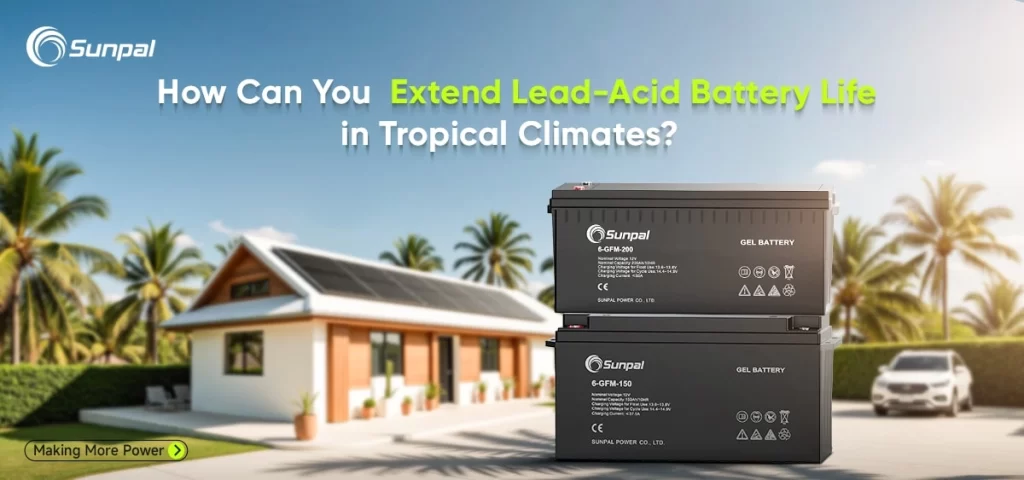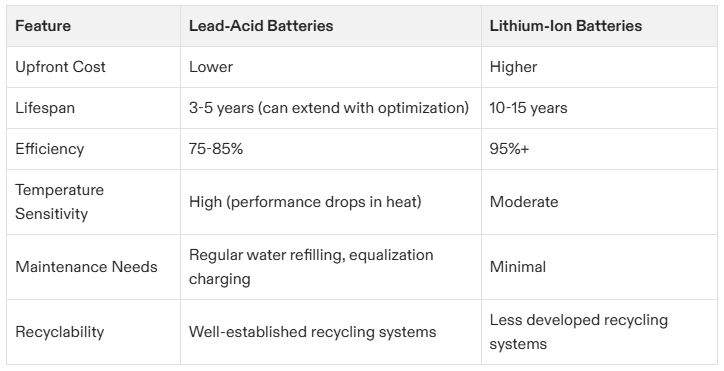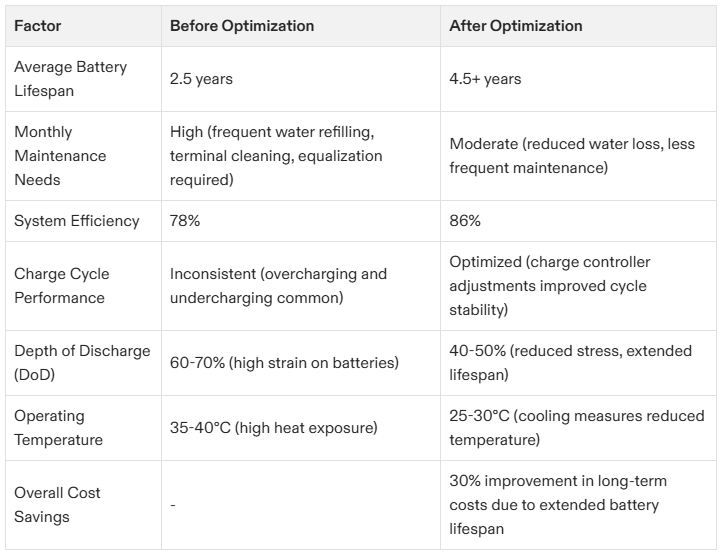
Reliable energy storage is essential for hybrid solar power systems, especially in cost-sensitive markets where lead-acid batteries remain a dominant choice. While newer lithium-ion technology is gaining traction, many businesses and homeowners still rely on lead-acid batteries due to their affordability and availability. However, without proper lead-acid battery optimization, tropical climates can accelerate battery degradation and significantly reduce lifespan.
This guide explores effective lead-acid battery optimization strategies to extend battery lifespan in hybrid solar systems, helping system owners maximize performance while keeping costs low.
Why Lead-Acid Batteries Still Matter in Hybrid Solar Systems
Despite the rise of lithium-ion alternatives, lead-acid batteries continue to be widely used in hybrid solar energy systems. Their lower upfront cost, familiarity among installers, and well-established recycling infrastructure make them a practical option. However, their performance in high-temperature and humid environments is a critical concern.
Lead-Acid vs. Lithium-Ion: A Cost-Benefit Perspective

Key Takeaway: While lithium-ion batteries have superior performance and longevity, lead-acid remains a viable option when cost is a primary factor—especially when optimized for longevity in challenging climates.
How Tropical Climates Accelerate Lead-Acid Battery Degradation
High temperatures and humidity are the primary threats to lead-acid battery longevity. In tropical regions, these environmental factors cause:
- Increased Water Loss: Heat accelerates electrolyte evaporation, leading to dry cells and reduced capacity.
- Sulfation Build-Up: Rapid charge/discharge cycles combined with heat lead to sulfation, where lead sulfate crystals form on battery plates, reducing efficiency.
- Corrosion and Grid Degradation: Humid conditions corrode battery terminals and internal grids, shortening operational lifespan.
Impact of Temperature on Lead-Acid Battery Lifespan

Key Takeaway: A 10°C increase above 25°C can cut battery lifespan by half. Effective temperature management is critical for maximizing performance.
Best Practices to Extend Lead-Acid Battery Lifespan in Hybrid Solar Systems
1. Temperature Management: Keeping Batteries Cool
Cooling Strategies:
- Install batteries in shaded, ventilated enclosures to reduce direct heat exposure.
- Use insulated battery boxes to minimize temperature fluctuations.
- Implement forced-air ventilation or small cooling fans in extreme climates.
2. Charging Optimization: Avoiding Overcharging and Undercharging
Proper charging ensures batteries remain in peak condition. Many systems use generic charge controllers, which may not be optimized for local climate conditions.
Optimized Charge Settings for Tropical Environments:
- Bulk Charge Voltage: 14.6V–14.8V per 12V battery
- Float Voltage: 13.4V–13.6V per 12V battery
- Equalization Charge: Performed monthly at 15V for 1-2 hours
Key Takeaway: Using a charge controller with temperature compensation prevents overcharging in hot weather.
3. Regular Maintenance and Water Replenishment
Flooded lead-acid batteries require regular maintenance to prevent premature failure.
Essential Maintenance Routine:
- Check electrolyte levels monthly and refill with distilled water as needed.
- Perform equalization charging to prevent sulfation build-up.
- Clean terminals to prevent corrosion.
4. Hybrid System Optimization: Reducing Battery Stress
Hybrid solar setups often integrate generators or grid power. Proper management of these secondary energy sources reduces battery cycling, thereby extending lifespan.
- Generator-Assisted Charging: Using a generator during high load periods prevents excessive battery discharge.
- Smart Energy Management: Implementing smart inverters and battery monitoring systems optimizes charge cycles.
Case Study: Improving Lead-Acid Battery Performance in a Tropical Solar Hybrid System
In a commercial solar hybrid project in Southeast Asia, a business using lead-acid batteries faced premature failures due to extreme temperatures and improper charging settings.
Solution Implemented:
- Installed shaded, ventilated enclosures to reduce heat exposure.
- Adjusted charge controller settings with temperature compensation.
- Implemented a monthly equalization charge to prevent sulfation.
- Switched to low-maintenance valve-regulated lead-acid (VRLA) batteries.
Results Achieved:

Key Takeaway: A few low-cost optimizations resulted in a nearly 80% improvement in battery lifespan.
Is Lead-Acid Still a Viable Choice for Hybrid Solar Systems?
Lead-acid batteries remain a practical solution for cost-sensitive hybrid solar applications. However, they require proper maintenance, optimized charging, and heat management to perform well in tropical climates.
For those seeking a low-maintenance, longer-lasting solution, lithium-ion is an alternative. However, lead-acid remains the best choice where affordability and recyclability are top priorities.
FAQs: Lead-Acid Battery Optimization in Hybrid Solar Systems
Q1. How often should I check my lead-acid battery in a hybrid solar system?
It's recommended to check electrolyte levels and perform a general inspection at least once a month. Equalization charging should be performed every 1-2 months.
Q2. Can I use lithium-ion batteries instead of lead-acid?
Yes, but lithium-ion has a higher upfront cost. If you're operating in a tropical climate and are on a budget, properly maintaining lead-acid batteries can be a more cost-effective solution.
Q3. Does high humidity affect lead-acid battery performance?
Yes. High humidity can cause corrosion on battery terminals and connections. Keeping batteries in a well-ventilated, dry area helps prevent damage.
Q4. What's the best way to cool lead-acid batteries in hot climates?
Install them in shaded areas, use cooling fans if necessary, and avoid placing them in direct sunlight.
Q5. How does Depth of Discharge (DoD) impact lead-acid battery lifespan?
Depth of Discharge (DoD) refers to how much of a battery's capacity is used before recharging. A lower DoD (e.g., 40-50%) helps extend lifespan, while deep discharges (over 70%) shorten it.
Q6. What is the ideal charging voltage for lead-acid batteries in a hybrid solar system?
- Bulk Charge Voltage: 14.6V–14.8V per 12V battery
- Float Voltage: 13.4V–13.6V per 12V battery
- Equalization Charge: 15V for 1-2 hours (performed monthly)
Q7. What are the signs of lead-acid battery failure?
Common signs include:
- Rapid voltage drops
- Reduced capacity and runtime
- Excessive heat during charging
- Swollen or leaking battery cases
Q8. Can I mix old and new lead-acid batteries in my hybrid solar system?
It's not recommended. Mixing old and new batteries can cause imbalance, leading to premature failure of the new batteries due to uneven charging and discharging.
Q9. How can I reduce lead-acid battery maintenance needs?
- Use sealed VRLA (Valve-Regulated Lead-Acid) batteries for lower maintenance.
- Ensure proper charge controller settings to minimize water loss.
- Keep battery terminals clean and corrosion-free.
Q10. Should I use a battery monitoring system for lead-acid batteries?
Yes! A battery monitoring system (BMS) helps track voltage, temperature, and state of charge (SoC), preventing over-discharge and improving performance.
Conclusion: Maximizing Lead-Acid Battery Lifespan in Solar Hybrid Systems
With strategic optimization, lead-acid batteries can provide years of reliable service in hybrid solar power systems, even in the most demanding tropical conditions.
- Implement temperature control strategies to minimize heat damage.
- Use optimized charging settings with temperature compensation.
- Perform regular maintenance to prevent sulfation and water loss.
- Reduce battery stress by integrating hybrid energy sources like generators.
Sunpal Energy provides expert guidance and solutions for extending battery performance in hybrid solar systems. Whether you're upgrading an existing system or planning a new installation, the right strategies can maximize the lifespan of lead-acid batteries and ensure cost-effective energy storage.
